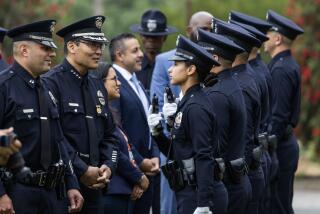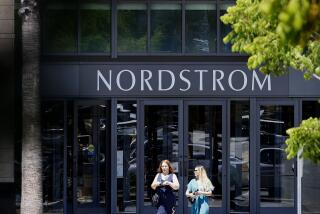Program Earns Praise : Crime Stoppers Celebrates Successful 1st Year
It may not be as popular as the movie “Ghostbusters,” but the San Diego Crime Stoppers--an organization that uses anonymous tips and rewards to solve crimes--has helped close 226 cases and led to the recovery of $2.5 million in property and narcotics during its first year, program officials say.
The program debuted in September, 1984, at the suggestion of San Diego Police Sgt. Bob Numley. It uses television reenactments of felonies to solicit information about the crimes.
So far, Crime Stoppers has reenacted 60 crimes, and 20 were solved after police pursued tips from the public. Combined with other leads phoned in to Crime Stoppers about cases not reenacted, there have been 64 suspects arrested because of the program, said Tom Varonsakis, a member of the program.
The program receives about 150 calls a month, and an average of 10 are useful to police. Varonsakis said Crime Stoppers has authorized $12,000 in rewards during its first year, but not all tipsters pick up the money because some are interested only in seeking justice.
The success of San Diego’s program has earned praise from members of the national Crime Stoppers organization, based in Albuquerque, N.M.
“They are one of the more successful programs during their first year,” said Coleman Tily, national executive director.
Numley said he suggested Crime Stoppers last year because a previous program to elicit help from the public was unproductive. “We had a tip program that wasn’t very successful but the need was still there,” he said. “So I shopped around.”
The success is based on two factors, Numley said. First, there is strict anonymity for those who volunteer information. Second, rewards are given for criminal arrests, not convictions.
Tily said these two factors assure helpful citizens that they won’t be harassed or become the target of revenge from any criminal. And the rewards help overcome apathy.
However, Tily said the makeup of the local Crime Stoppers board of directors, the support of local law enforcement agencies and the media also contribute to the program’s success.
The 16-member San Diego board includes President George Saadah, owner of Wurtz Interiors; Vice President Ted Owen of the Greater San Diego Business Assn.; a member of the San Diego Crime Commission; a minister; a Navy officer; an attorney, and an accountant.
In the San Diego area, Crime Stoppers is used by the San Diego, Chula Vista, El Cajon and Coronado police departments; San Diego County sheriff; the U.S. Coast Guard, and several fire departments.
Nine local television stations play the 60-second reenactments as public service announcements or as part of newscasts. Numley said the reenactments are played 28 to 30 times a week.
The reenactments are performed by actors, who even portray people who may have witnessed the crime, such as bank employees during a bank robbery. Numley narrates, describing what happened and what kind of information Crime Stoppers is seeking.
When a person calls with information about a specific crime or suspect, he is given a code number to use during all future contacts with Crime Stoppers, Numley said. The police investigate the information, and the citizen is asked to call back in a month to check results.
If an arrest is made, the tipster may receive a reward of $25 to $1,000 depending on how much information was given and the type of crime it helped solve.
To receive the reward, the tipster is asked to meet a member of the Crime Stoppers board of directors at a designated location and is paid in cash. No checks are used so the name is not revealed.
The nonprofit organization is funded by donations, from which the rewards are paid. It held its second fund raiser last month at the Hotel del Coronado and raised $13,600, said a spokesman for the group.
In addition to the reenactments, the Crime Stopper program operates two related programs--one for stolen vehicles and the other for fugitives.
The vehicle program, which began about seven months ago, uses two radio stations to announce license plate numbers of the stolen cars, thus reaching drivers on the road, where they are most likely to spot the autos in question. Those who help locate a stolen vehicle receive $25.
Since it began, 25 vehicles with a net worth of more than $100,000 have been recovered, program officials say.
The fugitive program was added about six months ago. Every two months, 10 faces of wanted suspects are put on flyers and distributed in public places, such as trolley and bus stops, and in hospital emergency rooms and post offices. Varonsakis said nine fugitives have been found through this approach.
More to Read
Sign up for Essential California
The most important California stories and recommendations in your inbox every morning.
You may occasionally receive promotional content from the Los Angeles Times.









